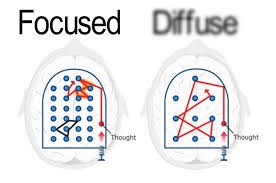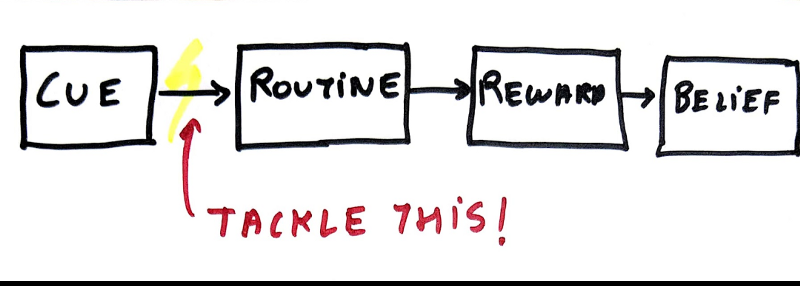By Yash Chavan
As a curious person, I constantly find myself reading and learning about new things. So I picked up this book A Mind for Numbers by Barbara Oakley to enhance and elevate my learning process. This blog post is my take on the ten most important things I think that learners should implement.
1. Just start, break the initial barrier.
Every task has a certain Activation Energy (AE). Say you want to practice playing the guitar. You have to get up, dust the old guitar, tune it, pick the plectrum up, and start strumming. All these make up the AE of the task of playing a guitar.
The higher the AE of something, the less likely are you to start doing the task. Take steps to reduce the AE of a new habit you want to start. Place the tuned guitar in your living room so you have it handy.
Want to start exercising every morning? Have your shoes and weights ready the previous night. Wanna read more? Keep a book at your desk. Reach for the book when you feel like checking your phone. Once you reduce the AE of new habits you want to form, it is easier to get started.
Getting started is all that counts, as most people don’t start ; )
2. Practice chunking
Ever been writing an exam and you kinda know the answer? You know the bits and pieces of what forms the answer, but you cannot put it all together?
This is an example of learning without chunking effectively. A memory chunk is a solid connection in your mind that relates various bits and pieces of information. A chunk is a series of thoughts that follows you directly as you starting thinking about the fundamental concepts.
How to chunk
Focus on the concept you want to form a chunk of, think about it, and make sure you eliminate all distractions while doing this. Next up, write down the basic ideas of what the concept is all about. Usually it boils down to having a strong understanding of the simplest concepts. Build up from these fundamentals to, finally, create a chunk!
3. Learn, Practice, Recall — Repeat
Just forming chunks is not sufficient. You have to maintain them. The more you look after the chunks, the longer they last.
Especially when it comes to subjects like mathematics and the sciences, you cannot leave it at the first read. In order to absorb the material well, you need to review the material and practice the problems on your own. Of course, all this might be boring, but it’s worth the trouble.
While you are reviewing the material, don’t passively read it. Make sure you recall. The act of retrieval via recall enhances deep understanding of the subject. A good place to start recalling what you learnt might be anywhere except where you studied it. This helps you strengthen the grasp of the material as you recall it from a different perspective. Learning in the library and recalling at home would be an example use case of this technique.
4. Take it easy
You almost have it. The clock says 2 am. Three cups of coffee down. You’ve devoted the past 4 hours on solving this very problem. This one breakthrough has the potential to get you an “A” on the assignment, resolve a major roadblock in your research, or make you millions. So you stick to it, waiting for the “aha!” moment.
It is morning now. 7 am. There was no breakthrough, you didn’t sleep at night. Now you’re groggy and spend the rest of today cursing yourself for how terrible you are at what you do. Major mistake!
Whenever you face a problem, this is a roadblock in whatever you are trying to solve. Pause. Take a break. Sleep. Clean your room. Do anything except work on the problem. This takes your brain into its “diffuse mode” — this mode works on the things you have been focusing on in the background. Come back to the problem later.

Have you ever been working on something you couldn’t figure out, then slept and “dreamt about it”? This is your diffuse mode at work. So take it easy, take a nap, and you’ll have some direction on what you’re trying to solve. And you never know, it might as well get you an “A” on the assignment, resolve a major research roadblock, or make you a million dollars!
5. Understand your procrastination and kill it
Whom would you call a procrastinator? A procrastinator is a person who has a habit of getting distracted by things and temporary pleasures (beep! bloop!, ding-ding!). These do not contribute to the task that must be done at this very moment.
Did you catch the magic word there? Habit. Procrastination is a bad habit. Just like any other bad habit, the habit of procrastination can be changed for the better.
Habits consist of 4 key factors:
- cue
- routine
- reward
- belief
The cue can be your phone buzzing with notifications. Your routine is to reach out to the phone and check it. The reward is the temporary dopamine spike that you get after seeing four new likes on your Instagram post. The belief is that the distracting habit makes you happy, and so you can never change this habit. Habits have power over you because of your belief in them. If you change your belief, you can change your habits!
The number one thing you can do to not procrastinate is to eliminate distractions. Don’t keep your phone near you when you work. Block all entertainment websites during your scheduled work time.
Another key to reduce procrastination is the Cue-Routine transition behaviour. Actively notice what you do in response to certain distracting cues. BING! Wanna check that phone desperately? Don’t. Resist the urge to reach out to it. Be mentally strong enough to focus intently on the work at hand. Your future self will thank you.
6. Set an ending time for tasks
You wake up. Check your to-do list, and make a mental note of what you have to do for the day. You start working on time (great!) but, at the end of the day, some items are left undone. Off to postponing tasks to tomorrow.
Parkinson’s second law:
Work expands so as to fill the time available for its completion.
Presuming that you have a realistic to-do list, this is what is preventing you from completing the tasks on your list. Once you start getting something done, your brain starts thinking that it deserves something. A reward, one episode, one look at the meme your friend tagged you in. And you are back into the procrastination spiral.
One way to tackle this is to set an ending time to tasks. You know, you do most of your work right before the deadline. Setting a micro deadline for daily tasks holds your brain accountable to the tick of the clock. Most people set a starting time for tasks and drop into procrastination loops. Setting an end time would help you do stuff on time.
7. Use visual and spatial memories
This one is about memorization and recall. The #1 thing you need to do to correctly memorize concepts is understand them. To successfully understand something, visualizing it is key. Feel it.
Want to memorize the physical equation for work? W = F*d. Don’t think of it as it is, in terms of the letters F and d. Visualize instead. Picture yourself pushing a cart, what are you doing? You are applying force to the cart and the cart is moving ahead by some distance. The work you do is proportional to the Force you apply (F) and the distance you move the cart for (displacement, d). F*d. Done.
As a kid, you might have been asked to do “actions” while you were reciting poetry. I found that weird. Weirdness aside, there’s a reason for that. Certain places and actions help us remember things. We associate events with actions and places. You can use actions or things to remember equations as well!

We have evolved as a visual and spatial species. We had to hunt and kill for a living. We needed spatial skills to understand how you should shoot the arrow, throw the spear. We had to visually remember how the poisonous plant looked. This is how we evolved, so take advantage of your primal traits.
8. Use metaphors and stories
Metaphors give you a tracing paper for the pattern you want to draw. Sure, you can draw the pattern yourself, but having the tracing paper is useful. Boom, I just used a metaphor to explain why you should use metaphors. Hit some claps for that.
Metaphors will help you understand and recall more easily. You take something obvious from your memory, and see how it is related to the new concept you are trying to learn. You are tracing over the preexisting neural pathways to create a stronger, more relatable view of the new concept.

Want to understand how current flows around in a circuit? Think of a water pump. The pressure is the voltage. The difference in pressure causes the water to move — the difference in voltage causes electrons to move. The pump itself is like the battery, it generates the pressure aka voltage. The flow of water is the current.
When you think of concepts in this manner, they are etched in your memory in a much better way than if you take them at face value.
9. Learn what you want
Learning should always be self-motivated, otherwise it isn’t real learning. If you live in a country like India, there is a high probability that whatever you are studying now in school or college was forced onto you. What schools fail to understand is that learning does not happen by sheer force and fear of failing. Learning should be learner-centered.
College is not the only way to learn (within reason)
If you are stuck in unimportant courses you do not like, don’t focus on them. Start learning what you want, since that is what actually matters — that is what you must care about. People learn when they are self-motivated, not when someone comes in front of them for four hours a week, and tells something to them. Mathematics, art, and science are not observer games. You have to do.
“I think the big mistake in schools is trying to teach children anything, and by using fear as the basic motivation. Fear of getting failing grades, fear of not staying with your class, etc. Interest can produce learning on a scale compared to fear as a nuclear explosion to a firecracker.” Stanley Kubrick
Self drive yourself — even cars do that. Learn what you want. You learn the best when you learn on your own.
10. Intersection of skills
Transfer learning (yes, machine learning pun intended) is the ability to take what you learn in one domain and apply it to a new skill. If you already know how to play a musical instrument, learning a new one would be easy for you.
Learn in an abstract manner. When you learn something in order to apply it to an application, you are restricted to that domain. Learn the abstract concept first. This is one of the reasons why I took a linear algebra course before I jumped to machine learning. Engineering and business-related studies naturally gravitate toward a more application specific approach. This tends to restrict you.
Learn to apply old skills to new skills and vice versa. Santiago Ramón y Cajal was a Spanish neuroscientist who had a hobby of painting. Once he was done observing cells in his lab, he would draw them! This helped him understand them better. Cajal is called the “Father of Neuroscience”. If he did it, you should too.

Once you transfer your learning, neural pathways associated with both concepts become stronger and improve your understanding of each.
BONUS!
If you’ve made it this far through the blog, I love you. Here’s another tip:
11. Sleep! (This is VERY important)
You have a test tomorrow morning at 9 am. You decide to stay up till 3 am to study for it. You cannot miss getting two points less than your overly competitive friend. So you make coffee, and you’re hustling all night for the test.
Fast forward two days, results are out. You scored no better than last time despite pulling an all-nighter. What went wrong, you ask?
The very fact that you stayed up all night is what went wrong. What you did was cram, you did not understand. There was no chunking, all your brain saw was words and numbers that did not make sense to it.
Lack of sleep affects memory and recall. Your brain is a muscle. If you run a marathon, your legs need rest. Your brain runs a marathon every single day. It needs a minimum of 7–8 hours of “rest”. Prepare for tests early on, do not save it for the night before.
If you are the kind of person who is passionate about the stuff you do, it is tempting to stay up late to complete the tasks you love. But you must sleep. Sleep helps your brain get into the diffuse mode and thus gets creative ideas about your ongoing projects cooking. A good sleep improves your focus, and helps you better understand what you learnt throughout the day.
REM sleep can help you improve your declarative memory — memory based on complex factual information. Thus, getting good sleep is especially useful for students who have to deal with facts and figures.
So sleep! It is not a waste of time. It affects you more than you think it does.

Thanks for reading! I hope this helped you. Leave some of them claps if you liked it! Do you have your own tricks that you use? Leave them in the comments below :)
I write about Life, Work, Machine Learning, and almost anything I find interesting on Medium. Follow me if you’re into this.
Connect with me on Instagram and LinkedIn for a one-on-one chat.
Crush the next semester!

